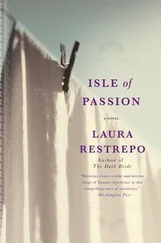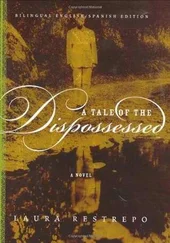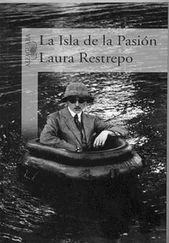“Maybe they grieved for many women, each man for his own,” acknowledges Sacramento today, “but to me it was as if they only spoke of her. No other names entered my ears, only Sayonara, Sayonara, falling like snow onto the high treetops in the midst of the suffocating heat, and I couldn’t believe that there was any greater passion than the one that emanated from her.”
Without knowing how or when, Sacramento began to build his life upon the messianic obsession of rescuing the beautiful object of his fantasies from her wrong path, apparently without suspecting that he knew her in flesh and blood — very little flesh and blood — because that distant Japanese girl with the legendary wake who pursued and trapped him was the same skinny girl that he had personally taken to Todos los Santos to teach her how to be someone, before she had a rare and exotic name but was simply called “the girl,” and she didn’t come from the Orient, like the three wise men, but from some pueblo like so many others whose name nobody bothered to ascertain. And she held no fascination or mysteries, just the existence of a cornered, hungry animal, with such force of character, freedom of spirit, and mulish stubbornness, that if Sacramento had been an attentive reader of souls, like Todos los Santos, he also would have perceived — or did he perceive it? — that the ordinary girl could convert herself into a living relic of the oil world, with the sole requirement that she choose to do so.
Each time Sacramento came upon civilization, the first thing he did, even before using a washbasin to rinse his face, or sitting down in front of a plate of hot food, was to send a postcard addressed to the girl in Tora, via the occasional traveler, migratory workers, the river mail, or the comings and goings of the mule drivers. He did it just like that, out of an affectionate impulse, the natural inclination toward the only thing in his life that resembled rootedness. Without fully comprehending that a mocking fate, which amuses itself at the expense of mortals, obliged him to send missives to someone who he adored without knowing it, and forced him to pursue through the labyrinth of roads precisely that which he had left behind.
They were colorful postcards with photographs and motifs of unexpected themes and diverse nationalities, on the backs of which Sacramento scrawled a few gerunds bearing his greetings. Like a FAÇADE OF THE PANCHAYAT PALACE IN KATMANDU, CAPITAL OF NEPAL, which read: “Thinking of you and remembering you, nothing more for the moment, Sacramento.” Or a LADIES FROM TOLEDO IN TYPICAL DRESS MAKING THE TRADITIONAL LACE OF THE REGION, with a note on the reverse that added adverbs to the usual gerunds: “Everything going well hoping the same for you remembering you affectionately and also señora Todos los Santos.” Or Sayonara’s favorite, PLATE AND VEGETABLE DISH IN DELICATE SEVRES PORCELAIN, on which was written, in blue ink, the following courtesy: “Hoping and wishing to see you again soon, yours respectfully Sacramento.”
Sayonara received them with jubilant shouts as if they were what they actually were, updates on pasteboard that reached her hands through mysterious routes from other worlds to notify her that she wasn’t alone in this one. She would interrupt whatever she was doing to take them from house to house, showing them to her friends, and after reading each one many times, she would stick them with tacks to the wall around the red Christ, forming a rhombus, a circle, a butterfly pattern, or other figures, sometimes geometrical, sometimes whimsical, that were covered with the vermilion reflections of the votives and in some impious way were integrated with the fascination and panic that the sacred space inspired in her.
Each time she received a new postcard, Sayonara disapproved of its corresponding place on the wall according to the old design. So she would pull them all down, taking advantage of the opportunity to read them again, shuffle and mix them, and arrange them again, one by one, letting herself be guided by impulses or whims. PLATE AND VEGETABLE DISH IN DELICATE SEVRES PORCELAIN now far from QUEEN ELIZABETH II OF GREAT BRITAIN and to the right of TORERO EXECUTING A PASS WITH CAPE ON A YOUNG BULL; DANCE CLASS, OIL PAINTING BY PIETRO LONGHI diagonally across from LACQUERED TABLE WITH CHINOISERIE, DETAIL; SECTION OF THE GARDENS OF LUXEMBOURG next to BALCONY OF THE QUINTA DE BOLÍVAR SANTAFÉ DE BOGOTÁ, and so on indefinitely, in variable and cabalistic order that neither she nor anyone else could interpret but that seemed to be foreshadowing the course of the events of her life.
Through the American Frank Brasco, I came to know of Sayonara’s fascination with snow, despite her never having seen it, or perhaps precisely because of that.
“You must be crazy, Sayo,” Brasco said to her. “We’re melting at ninety degrees in the shade and you’re asking me about snow…”
To Sayonara, a woman of the tropics accustomed to the frenzy of a vegetation perpetually sprouting and blossoming, to a voracious and persistent green that in a matter of hours swallows anything that remains still, the immobile silence of snow-covered fields must have been very perplexing. That sleepy landscape, hidden beneath an immense whiteness, barely conceived from photographs and postcards, must have been pure magic to her, or merely the hoax of foreigners, as if someone were to swear to a European that in other latitudes the sky stretched in red and white squares, like a quilt.
“She was more than simply curious,” Frank Brasco assured me. “That snow, which she had never seen, created a deep longing within her; it was something she needed urgently, who knows why.”
Otherworldly and overwhelming — as if seen through Sayonara’s eyes — the forests of this wintery Vermont appear before me, where Brasco the engineer was born and later spent many winters, until he finally established himself here permanently, now retired and at the doorstep of old age, in the midst of an austerity and a voluntary isolation that one could say is almost hermetic. I’ve come here looking for him because I have learned that he treasures memories of the time he worked for the Tropical Oil Company as general supervisor of Campo 26. He was at the time a man with a liberal attitude, accustomed to conducting relationships with women within the scope of a university environment, to such a degree that the possibility of seeking love in the world of prostitution had never even occurred to him. Besides, a bad case of poorly tended hepatitis in his childhood had left his liver sensitive to and incompatible with alcohol, so he considered himself immune to what he thought were the reasons that pushed the rest of the men as a mass toward the barrio of La Catunga. For that reason, despite regularly going down from 26 to the neighboring city, Frank Brasco had never crossed the boundaries of the zona de tolerancia and certainly would never have if chance hadn’t caused, for a few revealing and fascinating days, his path to cross with that of Sayonara, the dark lover of Tora.
“What was the first thing you noticed about her?”
“From the very first moment, I was shaken by her beauty and pained by her excessive youth, because she was practically a girl. A beautiful and frightened girl, like a feline, and dedicated to being a puta . But I also immediately perceived an unyielding temperament and a certain, unusually powerful intensity. How can I describe it? A human warmth that kept her capacity for expression intact. Not that she was always affectionate, or happy. Sometimes, it was just the opposite, she would walk past you so absorbed in her affairs that she didn’t even notice that you were there. But at those moments her presence weighed on you, and you couldn’t avoid it. Every movement of her body, every sentence she spoke, her way of looking at something or laughing, everything about her was naturally surprising and not premeditated, was sure, exact. As if the earth were a planet populated by extraterrestrials and she was the only one who had really been born here.”
Читать дальше












